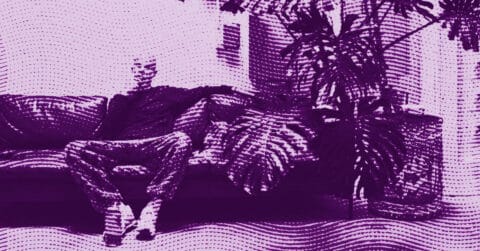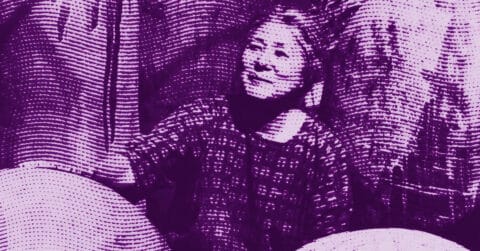Listen to me carefully, you bunch of snobs: Sharon Lockhart does not do things delicately. This American born in 1964, based in Los Angeles, has spent nearly three decades forcing us to look at what we prefer to ignore: female workers, anonymous children, teenage girls labeled as “misfits”. Armed with a fixed camera and a patience that borders on stubbornness, she imposes a duration that unsettles our brains accustomed to constant channel surfing. Her films stretch, repeat themselves, refuse spectacle. Yet, something happens. In this programmatic slowness, in these repeated gestures until hypnosis, emerges a form of resistance against the general acceleration of our lives.
Lockhart’s work is part of a claimed lineage with auteur cinema, particularly that of François Truffaut and Jean Rouch. When she films Milena Słowińska, this young Polish woman met in the dilapidated courtyards of Łódź in 2009, reenacting the final scene of Les Quatre Cents Coups in Antoine/Milena (2015), she does not settle for nostalgic homage. Milena’s face facing the camera, that look that pierces us with a mix of challenge and vulnerability, reactivates the subversive power of Truffaut’s film [1]. Where Antoine Doinel ran toward the sea to escape the confinement of French society in the 1950s, Milena embodies contemporary maladjustment, that of girls placed in institutions, labeled as “difficult” or “unmanageable”.
This reference to the Nouvelle Vague cinema is not accidental. Truffaut understood that filming childhood involved giving up established hierarchies, taking seriously the desires and revolts of the youngest. Lockhart pushes this logic even further. In Rudzienko (2016), filmed at the Center for Sociotherapy for Girls in Rudzienko, Poland, she organizes philosophy, theater, and movement therapy workshops with about fifteen teenage girls. The resulting film alternates fixed shots of rural landscapes and texts of philosophical conversations. The girls talk about God without speaking about God, as that would be against the rules, free will, and mistakes that reveal things. Lockhart films bodies moving in nature, joyful runs in the darkness, acts of fleeting freedom. Like Truffaut, she refuses the usual condescension toward minors. Like Rouch in his ethnofictions, she deliberately blurs the boundaries between documentary and staging.
Jean Rouch, this French filmmaker-anthropologist who filmed in Africa with a participatory camera, constitutes the other major reference for Lockhart. She explicitly cites his influence, particularly his way of having people play their own roles while introducing choreographed elements. In Goshogaoka (1997), her first feature film, Lockhart films for an hour a women’s basketball team from a suburban Tokyo high school performing elaborate training exercises. What seems spontaneous is actually meticulously choreographed. The camera remains stationary, but the players create the visual movement. This hybrid approach, between ethnographic observation and arranged performance, owes everything to Rouch. Lockhart practices what could be called an ethnofiction of ordinary life: she immerses herself in communities, learns their codes, earns their trust, then builds with them images that say something about their reality while being openly constructed.
The parallel with Rouch goes further. In Teatro Amazonas (1999), Lockhart films for twenty-four minutes an audience seated in the neoclassical opera house of Manaus, Brazil, who look directly at the camera, and thus at us, viewers. The Amazonian choir, off-screen, performs an original composition by Becky Allen that starts from a massive chord then gradually fades. As the music diminishes, the noise in the hall increases. This reversal of the gaze, where the observed becomes the observer, recalls Rouch’s experiments with the “participatory camera” and the questions he raised about the ethics of representation. Who watches whom? Who holds the power in the act of filming? Lockhart transforms these questions into a formal device.
The other territory of Lockhart’s exploration, the one that connects her intimately to the world of dance and movement, is embodied in her posthumous collaboration with Noa Eshkol, Israeli choreographer, dance theorist, and textile artist who died in 2007. Lockhart discovered Eshkol’s work shortly after her death, during a research trip to Israel sponsored by the Jewish Federation of Los Angeles. This encounter with the work of a deceased artist led to one of the most singular collaborations in contemporary art: a dialogue between an American filmmaker and the legacy of an Israeli choreographer, transmitted by the dancers of the Noa Eshkol Chamber Dance Group [2].
The Eshkol-Wachman movement notation system, developed by Eshkol with architect Avraham Wachman in the 1950s, uses numbers and symbols to map spatial relationships between parts of the body. It is an attempt to create a universal language of movement, halfway between geometry and choreography. Lockhart films Eshkol’s dancers meticulously performing these compositions in Five Dances and Nine Wall Carpets by Noa Eshkol and Four Exercises in Eshkol-Wachman Movement Notation (both 2011). The video installation, on five channels, presents the dancers at life size at floor level, moving to the rhythm of a resounding metronome, as if they blended with museum visitors. This staging creates a disturbing coexistence between the living and the ghosts of an artistic practice threatened with disappearance.
What interests Lockhart about Eshkol is the meeting between geometric formalism and deep humanism. Eshkol was a purist who sought in her dances to “renounce the use of all tools that are not intrinsically linked to movement,” including costumes, music, and dramatic lighting. Her wall tapestries, made from recovered colored fabric scraps, existed as separate works, unrelated to the dances. Yet, Lockhart chose to include these tapestries as decorative elements in her films, pinned on freestanding vertical blocks, a choice Eshkol probably would not have approved. This is the paradox of Lockhart: she deeply respects the artists she studies, but she does not fetishize them. She allows herself to reinterpret their work according to her own visual logic.
Lockhart’s fascination with the Eshkol-Wachman notation system reveals her broader obsession with systems of encoding human movement. In Lunch Break (2008), she films in a single slow-motion tracking shot a hallway of lockers where workers at a Maine shipyard eat their lunch. The camera movement, hypnotically slow, stretches eleven minutes of real-time event into eighty-three minutes of film. Every gesture, unwrapping a sandwich, reading a newspaper, chatting with a colleague, acquires a choreographic dimension. The lunchboxes, photographed separately, become proxy portraits of their owners. Lockhart applies here to the American working class the same meticulous attention that Eshkol gave to the geometric decomposition of movement. She creates a visual notation of work and break, documenting rituals that no one deems worthy of being filmed.
This dual lineage, with engaged auteur cinema and with conceptual dance, allows Lockhart to develop a unique formal language. Her films do not tell stories. They create durations. They impose a viewing time that is also a time of thought. When she films workers eating silently for eighty-three minutes, when she films for an hour a Japanese basketball team practicing, when she films Polish teenage girls talking on the grass for forty minutes, she forces us to abandon our narrative expectations to enter a different relationship with time and image.
The Little Review project presented at the Polish Pavilion of the Venice Biennale in 2017 synthesizes all these concerns. Lockhart pays homage to Janusz Korczak, a Polish educator and child rights activist who created from 1926 to 1939 a newspaper entirely written and edited by children. With the girls from Rudzienko, she translates selected issues of the Mały Przegląd into English for the first time, weaving a dialogue between past and present, showcasing adolescent bodies in motion, filmed against a black background in vignettes evoking both theater and dance. The sticks the girls wield in the last minutes of the film, gathered in Californian forests, become feminist totems, symbols of regained power [3].
Lockhart works slowly, continually returns to the same places, the same people. She filmed the Pine Flat community in California for four years, went back more than fifteen times to Poland to see Milena and her comrades, spent over a year with the workers of Bath in Maine. This prolonged immersion method, inherited from visual anthropology, allows her to go beyond the tourist gaze to reach something like intimacy. But it is never a comfortable intimacy. Her images always maintain a distance, a frame, a composition that reminds us it is a construction. “Art exists to make us think and see differently,” she asserts [4].
Her latest film, Windward (2025), shot on Fogo Island in Newfoundland, returns to childhood but in an almost pastoral register. Twelve tableaux show children playing in grand natural landscapes. No phones, no screens, no apparent climate crisis, an almost Edenic vision that sharply contrasts with our present. Some will see nostalgia in it. Others, provocation: what if slowing down, observing, giving children and nature time already constituted a political gesture?
Lockhart’s work offers no easy answers. It does not flatter the viewer. It demands. It tests our attention span, our tolerance for boredom, our desire for narrative. But for those who agree to submit to her particular temporality, something happens. Gestures become charged with meaning. Silences become eloquent. Ordinary bodies acquire monumental dignity. In a world saturated with instant and disposable images, Lockhart creates durations that resist, presences that endure. She reminds us, with an obstinacy that may seem anachronistic, that truly looking takes time. That understanding the other requires patience. That social justice may begin with this simple act: giving attention to the lives our society prefers not to see.
Her work thus constitutes a form of silent but tenacious resistance against the attention economy that governs our era. Every fixed shot, every additional minute, every refusal of rapid editing asserts the value of long time, sustained observation, maintained presence. By choosing to film marginalized communities, children from remote villages, shipyard workers, troubled teenage girls, dancers perpetuating an endangered tradition, Lockhart never falls into misery porn or exoticism. She offers them what our society denies them: time. Time to exist on screen, time for their gestures to unfold, time for us, the spectators, to truly learn to see them. Perhaps that is, ultimately, her most radical gesture: transforming time into a gesture of valuing. In her films, no one is rushed. Nothing is edited in the name of narrative efficiency. Boredom becomes method, duration becomes political, and slowness becomes an act of care.
- François Truffaut, The 400 Blows, film, 1959
- Exhibition Sharon Lockhart | Noa Eshkol, co-commissioned by the Los Angeles County Museum of Art and the Israel Museum in Jerusalem, 2011
- Sharon Lockhart, Little Review, installation presented at the Polish Pavilion, 57th Venice Biennale, 2017
- Sharon Lockhart, interview in Frieze, June 2005
















